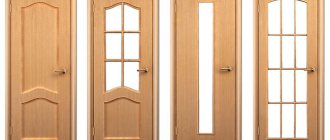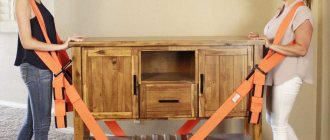What is a pantograph for a wardrobe
Many people do not know what a cabinet pantograph is. A pantograph is a special device for storing clothes in the ceiling of a closet. The design saves space and simplifies the process of hanging and taking out clothes. The pantograph allows you to place 20-50% more things in the closet.
This design is inferior to the usual horizontal crossbar for hangers, which can last forever.
The pantograph ensures comfortable placement of dresses, suits and shirts at the top. Below there are shelves with other things that do not require special care. This could be bags, underwear, accessories, shoes, etc. The device is ideal for small apartments where there is always a shortage of space.
This is a metal and plastic structure in the form of a U-shaped connection, designed for hangers.
The lever design is functional and easy to use. Pantographs in wardrobes appeared on the market relatively recently, but have already become widespread. Installing a structure can increase the comfort of life, which is why many people prefer such equipment.
Features and principle of operation
The design of the pantograph is not complicated. The service life depends on the quality of the materials used and the processing of parts. When choosing, you should give preference to trusted manufacturers; saving in this case is not practical. Cheap models often break down after just a couple of months; repairs take a lot of time and effort. In most cases, it is cheaper to buy a new mechanism than to repair an old one.
With its help you can easily remove clothes from the upper sections of furniture.
The device consists of the following elements:
- levers – load-bearing elements for manipulating the barbell;
- lifting mechanism - a complex system that sets the entire structure in motion;
- rod - a telescopic handle with the ability to change length, designed for hanging clothes;
- handle - designed to control the pantograph.
Pantographs for sliding wardrobes are divided into electric and manual (mechanical).
The brackets are fixed to the walls of the wardrobe, the height depends on the length of the handle of the structure. The distance from the ceiling of the wardrobe to the end of the handle should be 3-5 mm. The handle is easy to put on; the plastic castings snap onto the “ears” of the bracket. The telescopic pipe is fixed to the bracket handle with screws.
Weight category 10-15 kg – not suitable for heavy winter jackets, down jackets and fur coats, will not support their weight.
Pantographs with mechanical and electric levers are available for sale. A wardrobe lift works on the same principle, but its installation requires more time and effort. A mechanical pantograph can be installed on your own; installation of a model with an electric drive requires professional knowledge.
The furniture pantograph can withstand loads of up to 20 kg. The manufacturer always indicates the maximum weight. The length of the device is 45-125 cm. The longer the structure, the more weight it can withstand.
Simply pull the special handle (item 5 on the list), and the entire barbell with hangers will go down.
The most vulnerable part of the structure is the springs, due to which the levers are lowered and raised. Malfunctions most often occur from overloads or strong jerks. Good manufacturers use quality springs designed to last for many years. Compliance with operating rules plays an important role.
What is a furniture pantograph for clothing
According to its purpose, a pantograph for a wardrobe is a furniture elevator, a special lifting device with a bar-bar for placing clothes on hangers. The device allows you to place hangers with clothes in the upper part of the closet, and just pull the special handle so that the bar lowers for viewing to a convenient level. There are several types of pantographs; based on each criterion, the optimal choice can be made.
By design
The classic design of a pantograph is a U-shaped metal frame with plastic fasteners.
Advantages and disadvantages
Installation of a lever mechanism significantly increases comfort in everyday life. Elderly people and patients with disabilities can deliver and hang clothes themselves.
Pay attention to the sliding doors and shelves; they should not interfere when lowering, and the handle should be at a comfortable height.
Advantages of a pantograph:
- acceleration and simplification of manipulations with things in the closet;
- improved ventilation, things stay fresh;
- freeing up space at the bottom of the cabinet;
- reduction of ironing time.
Mechanical analogues are in great demand as they are cheaper.
The main disadvantage of the pantograph is considered to be relatively rapid wear. Mechanism malfunctions occur on average after 3-4 years. The main reason is considered to be the formation of backlashes between individual structural elements.
With a slight movement, the clothes on the hangers fall down and then smoothly rise up again.
Disadvantages can also include creaking. Extraneous sounds can become a real problem if the closet is located in a shared bedroom. The cost of a pantograph often exceeds the price of a regular crossbar, so it should also be considered a disadvantage.
Pantograph - what is it?
Pantographs for clothing: what to look for when choosing.
For their own convenience, owners of large wardrobes will find it useful to purchase a pantograph for clothes - part of the “smart closet” system, which will allow you to keep all things in order and have optimal easy access to them. The furniture pantograph comes in various sizes and is presented to the client in two versions depending on the basic type of mechanism: telescopic and hydraulic. A pantograph is a special U-shaped or L-shaped structure made of durable steel and plastic, which allows you to raise and lower the bar under the hangers using a control handle. Thanks to the pantograph, compartments with clothes can be located in the upper part of the closet, inaccessible for your height, freeing up space below for shelves and pull-out baskets.
Classic (mechanical and hydraulic) pantographs consist of several parts:
- Side levers. The main load-bearing elements that support the weight of clothing and must be rigid so as not to deform when the structure is raised and lowered;
- Telescopic rod. There are hangers with clothes on it. In order not to select a separate size for a niche, the rod is made extendable to change the length. The possible size range is always indicated on the packaging, do not forget to check this aspect when purchasing;
- Fixing elements. With their help, the structure is attached to the walls of the cabinet. They must be strong and wear-resistant; if there is anything to break in the product, it is the fixing units;
- Lifting mechanism. It consists of two parts, which are located where the structure is attached to the cabinet walls and are hidden by plastic covers. Responsible for the easy descent and ascent of the pantograph and must be of high quality in order to last a long time;
- Lever. Available in mechanical models and needed for lowering and raising the bar.
There are also electric pantographs
– their design has slightly different features. They are controlled by a button connected by a wire to the system unit or remote control. Electric ones are much more convenient to use, but require complex installation by a qualified electrician. Electrically driven pantographs are generally made to order. In this article we will look primarily at mechanical pantographs, as they are more affordable and easier to install in a cabinet. In most cases, a pantograph helps improve the quality of life. But it also has disadvantages.
- allows optimal use of useful space in the closet;
- hanging things is much easier due to the fact that the crossbar is located behind the closet and is at a low height.
- improves ventilation: clothes are fresher;
- facilitates the use of the cabinet for the elderly and people with disabilities;
- frees up the lower part of the cabinet for additional shelves;
- reduces the need for ironing: you can hang more clothes than in a regular closet.
The main disadvantage is wear and tear over time. Gradually, backlashes form between the structural parts, which disables the entire mechanism. It is almost impossible to repair individual parts of the pantograph; the entire system has to be replaced. Another drawback is the possible creaking of parts during operation. This becomes a problem if the closet is located in a shared bedroom. Compared to a regular bar, pantographs are significantly more expensive and require more complex installation.
When choosing a pantograph, you should pay attention to the following characteristics:
- Material. Steel parts are durable, aluminum parts last less. The plastic must be highly durable.
- Load capacity. Focus on the average weight of clothing. If it exceeds the load-carrying capacity of the device, then failure in a short time is inevitable. It is better to purchase models with a load capacity of 12, 15, 18 kg, with the exception of small sections of the cabinet.
- Type of lifting mechanism. It is better to choose pantographs with gas and hydraulic lifting mechanisms. These lifts have a soft ride and will last longer than spring mechanisms.
- Manufacturer. Models from Chinese manufacturers are cheaper, but they creak more often, do not work stably, and are poorly fixed at the lower level.
- Control type. In this matter, they focus on the budget. Of course, electrical devices are more convenient than mechanical ones.
- Bar sizes. The dimensions of the rod are indicated on each model. When choosing, they are guided by the width of the cabinet section where the pantograph will be mounted. The bar should be positioned freely between the walls and not touch the doors while moving. The removal of the rod outside the cabinet is also taken into account. This is important when space is limited.
How to choose the right one
Mechanical models are sold in stores, their cost starts from 2000 rubles. A pantograph with an electric drive will cost an order of magnitude higher, even with similar technical characteristics of the models.
Knowing all the pros and cons of a pantograph and what to look for when choosing, you can easily create comfort in your home compartment.
When choosing, you should pay attention to the following parameters:
- material of manufacture - steel is durable, aluminum wears out quickly, high-strength plastic must withstand loads;
- load capacity - the average weight of the clothing must be taken into account, it should not exceed the load capacity of the mechanism, the optimal parameter is 12, 15, 18 kg;
- type of lifting mechanism - gas and hydraulic are superior in performance characteristics to spring analogues;
- manufacturer - Chinese models are cheaper, inexpensive pantographs creak and are unstable, it is best to give preference to models from the brands SERVETTO, VIBO, AMBOS;
- rod dimensions - when choosing, you should focus on the width of the cabinet section, the rod should be located between the walls, and the doors should not swing;
- type of control - models with electric drive are considered more convenient;
- Manufacturers' warranty - the longer the warranty period, the higher the quality.
The design allows the clothes to be ventilated, which means that the smell will not appear.
Types of pantographs
Pantographs can be mechanical or electrical.
All models are divided by material of manufacture:
- steel;
- aluminum.
By rod width:
- 450 - 600 mm;
- 600 - 800 mm;
- 800 - 1150 mm;
- other parameters;
Pantographs are also designed for different load capacities. The kit comes with instructions and mounting hardware.
Mechanical
Mechanical pantograph
These are easy-to-install and operate devices. Lifting mechanisms are gas, hydraulic and spring.
| Mechanical models | ||||
| Manufacturer, model | SERVETTO ONLY | AMBOS 700 | VIBO Ambrogio | LEMAX |
| Lifting mechanism | hydraulic | hydraulic | hydraulic | hydraulic |
| Section width | 600-1200 mm | 750-1150 mm | 500-750 mm | 600-830 mm |
| Rod type | telescopic | telescopic | telescopic | sliding |
| Load capacity | 12 kg | 15 kg | 14 kg | 12 kg |
| Material | steel, plastic | chrome steel, plastic | steel, plastic | metal, plastic |
| Color | grey, brown | white | grey | silver |
| average price | 9100 rub. | 6200 rub. | 7050 rub. | 3250 rub. |
Types of pantographs and their characteristics
All pantographs protect things from being crushed and keep things in neat condition.
Mechanical
Mechanical ones operate on the principle of a multi-stage switch. The levers stop in two positions; some models provide intermediate positions. To return the hanger to its place, the rod must be moved to a different position.
When choosing a furniture elevator, focus on the load capacity.
Electrical
Control is carried out using a special button. Electropantographs are not much different from mechanical ones. It all depends on the specific model. The load capacity of such models does not exceed 20 kg. It is recommended to install the electropantograph in a children's room. The device will also be useful for older people. The average cost of such a model is 7 thousand rubles, which is not cheap.
A great option for children, the elderly, and people with disabilities.
Installation and operation rules
The pantograph is mounted on the sides of the cabinet, on laminated chipboard. Before installation, you should be careful about self-tapping screws. Their length should not exceed 16 mm. The kit often includes slightly longer screws. They can go through the closet wall, which looks unsightly.
Mechanical options are installed in a similar way, except that they do not need to be connected to the network.
Some models are mounted directly on the wall. They are intended for dressing rooms.
Installation steps for an electric pantograph, which is activated by a button:
- unpack, check how it works, connect to the network;
- measure the distance from the outlet; it should be enough to connect the device;
- take clothes out of the compartment, try on the mechanism, make notes for installing fasteners (in the absence of documentation, measurements are carried out manually);
- drill holes at the fastening points;
- install the frame into the grooves.
The pantograph will work immediately after connecting to the network. Control is carried out using a button or pedal. The hanger rises and falls in just a couple of seconds after pressing.
Most pantographs have a rod clearly in the middle to evenly distribute the center of gravity.
Mechanical pantographs are installed in a similar way. The only difference is that there is no need to connect the mechanism to an outlet.
During operation, maximum loads should be avoided. The mechanism wears out quickly, so sudden movements should be avoided. When lifting an empty pantograph, the handle must be held with your hand, which will avoid inertial movement of the structure until it crashes into the wall. The presence of clothing will slow down the sharp movement of the mechanism, the handle will also slow down on the clothing. The mechanism does not require special care; careful operation will help to avoid malfunctions.
It is very easy to get any item from your wardrobe if you have a pantograph. Take advantage of modern solutions.











